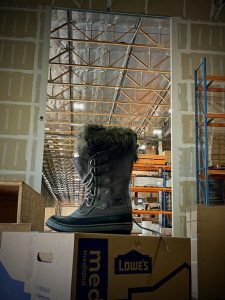Michael R. Hicks's Blog
August 1, 2025
For Authors: start Your Mailing List
I’ve been self-publishing since 2008, have put out 16 novels with another on the way, and lived VERY well on my book royalties for a number of years before my muse up and left for an extended vacation. If there’s one piece of advice I’d give aspiring authors, it would be to START A MAILING LIST ASAP AND NEVER STOP GROWING IT!
Let me tell you why.
By 2016, when my muse went bye-bye, I had over 80,000 followers on Twitter, 5,000 on Facebook, >7,000 on BookBub, and >7,000 on my mailing list. Granted, things were a LOT different then than now on social media, but looking back, I’d offer up a few observations:
Social media is a great place to connect with readers, but even when I had a lot of followers on Twitter and was very active on FB, that didn’t convert into many sales or downloads of loss-leaders. Some, yes, but not a ton for the time I invested on those platforms, and most were actually from other accounts spreading the word. Again, I’m not saying social media is a waste of time, but it’s not a great place to “sell books.” BookBub ads can be a fantastic way to help promote your books, especially the inexpensive new release emails to your existing followers there. However, building up that list can be extremely difficult and you don’t have a lot of control over engaging with them as a group, and some of the other paid ad options can get very pricey.While building up a good mailing list also takes a lot of time and effort, you can engage with your growing list of followers as you choose, when you choose. And when you put out a new release, this list (and the one on BookBub) is going to be your golden egg-laying goose.I had a gap of 7 years from 2016 to 2023 when my muse was on vacation (she returned in July 2023), and after multiple failed attempts to kick-start my writing, I finally dropped any pretense of publishing more books and went back to my government day job. I was still making residual sales, but certainly not anything that would support us financially as it had the previous six years.
One casualty of all this was my mailing list. I’d gone through several iterations of my web site. Another thing you MUST NOT DO is radically revise your web site content; change the theme all you want, but don’t tear it down and rebuild it, let alone multiple times – big mistake!. Anyway, during those iterations I unplugged the newsletter service and thought I’d lost my subscriber list.
Such was my joy the other day when I stumbled across it, buried in one of my book-related folders! I’d started rebuilding a list from scratch earlier this year and had added 133 people over the last few months. Granted, I wasn’t focusing that hard on it; too many other things going on; I’m sure you could get quite a few more than that in the same amount of time if you did the right things.
But as soon as I found my old list, I combined that and the new subscribers, punched it into the Newsletter plugin for my WordPress site, and sent out an email to let folks know I was still alive, lol! Only half the list has been served as I write this (I’ve throttled the output to keep under the limit for our web host), but I’ve received a boatload of emails and comments on the site from folks who were happy to hear from me and eager for the next book I now have in editing (Quest For The One). And the best part is that I can keep those folks engaged with other content, like posts about our relocation to France or whatever else comes along that they might be interested in.
When the new book goes out, all those folks will get notifications and you can bet that most of the people who open that email are going to go right out and buy the book, because those folks are on my list specifically because they like what I write and want more.
Anyway, the moral of the story here is that, IMHO, the very best investment of your time and effort to market your books over the long haul is building that mailing list. Invest the time to learn how to do it smart and right (I need to refresh on a lot of things; I was never very good at this), then KEEP AT IT. You’ll be glad you did.
The post For Authors: start Your Mailing List first appeared on Michael R. Hicks.
July 31, 2025
FLowers of Josselin
One of the many things I love about our new home in the medieval town of Josselin, France, is the emphasis the town puts on beautification, especially with flowers. A lot of it is done, of course, by the mairie (the local town administration, led by our mayor), but almost everyone here has flower boxes, planters, or some other way to get flowers out there. They also don’t cut down flowers that may be growing out of odd places like old stone walls or even sprouting up from cracks between the sidewalk and the walls of buildings. You literally can’t go more than a few meters here without finding more flowers.
The ones in the gallery here are mostly roses from the Jardin médiéval, with some others from community planters here and there. So, here are a few pics to bring you a bit of beauty and peace from France…
#bwg_container1_0 #bwg_container2_0 #bwg_mosaic_thumbnails_div_0 { width: 100%; position: relative; background-color: rgba(255, 255, 255, 0.00); text-align: center; justify-content: center; margin-left: auto; margin-right: auto; padding-left: 2px; padding-top: 2px; } #bwg_container1_0 #bwg_container2_0 .bwg_mosaic_thumb_spun_0 { display: block; position: absolute; border-radius: 0; border: 0px none #CCCCCC; background-color:rgba(0,0,0, 0.30); -moz-box-sizing: content-box !important; -webkit-box-sizing: content-box !important; box-sizing: content-box !important; } #bwg_container1_0 #bwg_container2_0 .bwg_mosaic_thumb_0 { display: block; -moz-box-sizing: content-box !important; -webkit-box-sizing: content-box !important; box-sizing: content-box !important; margin: 0; opacity: 1.00; } #bwg_container1_0 #bwg_container2_0 .bwg_mosaic_thumb_spun_0:hover { opacity: 1; backface-visibility: hidden; -webkit-backface-visibility: hidden; -moz-backface-visibility: hidden; -ms-backface-visibility: hidden; z-index: 102; } @media only screen and (min-width: 480px) { #bwg_container1_0 #bwg_container2_0 .bwg-container-0.bwg-mosaic-thumbnails .bwg-item0 img { -webkit-transition: -webkit-transform .3s; transition: transform .3s; } #bwg_container1_0 #bwg_container2_0 .bwg-container-0.bwg-mosaic-thumbnails .bwg-item0 img:hover { -ms-transform: scale(1.08); -webkit-transform: scale(1.08); transform: scale(1.08); } } #bwg_container1_0 #bwg_container2_0 .bwg_mosaic_thumbnails_0 { background-color: rgba(255, 255, 255, 0.00); font-size: 0; position: relative; text-align: center; display: inline-block; visibility: hidden; } /*image title styles*/ #bwg_container1_0 #bwg_container2_0 .bwg_mosaic_title_spun1_0, #bwg_container1_0 #bwg_container2_0 .bwg-mosaic-thumbnails .bwg_ecommerce_spun1_0 { position: absolute; display: block; opacity: 0; box-sizing: border-box; text-align: center; top: 50%; left: 50%; transform: translate(-50%, -50%); } #bwg_container1_0 #bwg_container2_0 .bwg-mosaic-thumbnails .bwg_mosaic_title_spun2_0, #bwg_container1_0 #bwg_container2_0 .bwg-mosaic-thumbnails .bwg_ecommerce_spun2_0 { color: #323A45; font-family: Ubuntu; font-size: 16px; font-weight: bold; text-shadow: ; vertical-align: middle; word-wrap: break-word; } .bwg_mosaic_play_icon_spun_0 { display: table; position: absolute; left: -10000px; top: 0px; opacity: 0; } .bwg_mosaic_play_icon_0 { color: #323A45; font-size: 32px; vertical-align: middle; display: table-cell !important; z-index: 1; text-align: center; margin: 0 auto; } #bwg_container1_0 #bwg_container2_0 .bwg_gal_title_0 { background-color: rgba(0, 0, 0, 0); color: #323A45; display: block; font-family: Ubuntu; font-size: 16px; font-weight: bold; padding: 2px; text-shadow: ; text-align: center; } @media screen and (max-width: 350px) { div[class^="bwg_mosaic_thumbnails_"], span[class^="bwg_mosaic_thumb_spun_"] { width: 100% !important; } img[class^="bwg_mosaic_thumb_"] { width: 100% !important; height: auto !important; margin: 0px auto !important; } }















 /*pagination styles*/ #bwg_container1_0 #bwg_container2_0 .tablenav-pages_0 { text-align: center; font-size: 12px; font-family: Ubuntu; font-weight: bold; color: #666666; margin: 6px 0 4px; display: block; } @media only screen and (max-width : 320px) { #bwg_container1_0 #bwg_container2_0 .displaying-num_0 { display: none; } } #bwg_container1_0 #bwg_container2_0 .displaying-num_0 { font-size: 12px; font-family: Ubuntu; font-weight: bold; color: #666666; margin-right: 10px; vertical-align: middle; } #bwg_container1_0 #bwg_container2_0 .paging-input_0 { font-size: 12px; font-family: Ubuntu; font-weight: bold; color: #666666; vertical-align: middle; } #bwg_container1_0 #bwg_container2_0 .tablenav-pages_0 a.disabled, #bwg_container1_0 #bwg_container2_0 .tablenav-pages_0 a.disabled:hover, #bwg_container1_0 #bwg_container2_0 .tablenav-pages_0 a.disabled:focus, #bwg_container1_0 #bwg_container2_0 .tablenav-pages_0 input.bwg_current_page { cursor: default; color: rgba(102, 102, 102, 0.5); } #bwg_container1_0 #bwg_container2_0 .tablenav-pages_0 a, #bwg_container1_0 #bwg_container2_0 .tablenav-pages_0 input.bwg_current_page { cursor: pointer; text-align: center; font-size: 12px; font-family: Ubuntu; font-weight: bold; color: #666666; text-decoration: none; padding: 3px 6px; margin: 0; border-radius: 0; border-style: solid; border-width: 1px; border-color: #E3E3E3; background-color: rgba(255, 255, 255, 1.00); box-shadow: 0; transition: all 0.3s ease 0s;-webkit-transition: all 0.3s ease 0s; } if( jQuery('.bwg_nav_cont_0').length > 1 ) { jQuery('.bwg_nav_cont_0').first().remove() } function spider_page_0(cur, x, y, load_more) { if (typeof load_more == "undefined") { var load_more = false; } if (jQuery(cur).hasClass('disabled')) { return false; } var items_county_0 = 1; switch (y) { case 1: if (x >= items_county_0) { document.getElementById('page_number_0').value = items_county_0; } else { document.getElementById('page_number_0').value = x + 1; } break; case 2: document.getElementById('page_number_0').value = items_county_0; break; case -1: if (x == 1) { document.getElementById('page_number_0').value = 1; } else { document.getElementById('page_number_0').value = x - 1; } break; case -2: document.getElementById('page_number_0').value = 1; break; case 0: document.getElementById('page_number_0').value = x; break; default: document.getElementById('page_number_0').value = 1; } bwg_ajax('gal_front_form_0', '0', 'bwg_thumbnails_mosaic_0', '0', '', 'gallery', 0, '', '', load_more, '', 1); } jQuery('.first-page-0').on('click', function () { spider_page_0(this, 1, -2, 'numeric'); return false; }); jQuery('.prev-page-0').on('click', function () { spider_page_0(this, 1, -1, 'numeric'); return false; }); jQuery('.next-page-0').on('click', function () { spider_page_0(this, 1, 1, 'numeric'); return false; }); jQuery('.last-page-0').on('click', function () { spider_page_0(this, 1, 2, 'numeric'); return false; }); /* Change page on input enter. */ function bwg_change_page_0( e, that ) { if ( e.key == 'Enter' ) { var to_page = parseInt(jQuery(that).val()); var pages_count = jQuery(that).parents(".pagination-links").data("pages-count"); var current_url_param = jQuery(that).attr('data-url-info'); if (to_page > pages_count) { to_page = 1; } spider_page_0(this, to_page, 0, 'numeric'); return false; } return true; } jQuery('.bwg_load_btn_0').on('click', function () { spider_page_0(this, 1, 1, true); return false; }); #bwg_container1_0 #bwg_container2_0 #spider_popup_overlay_0 { background-color: #EEEEEE; opacity: 0.60; } if (document.readyState === 'complete') { if( typeof bwg_main_ready == 'function' ) { if ( jQuery("#bwg_container1_0").height() ) { bwg_main_ready(jQuery("#bwg_container1_0")); } } } else { document.addEventListener('DOMContentLoaded', function() { if( typeof bwg_main_ready == 'function' ) { if ( jQuery("#bwg_container1_0").height() ) { bwg_main_ready(jQuery("#bwg_container1_0")); } } }); }
/*pagination styles*/ #bwg_container1_0 #bwg_container2_0 .tablenav-pages_0 { text-align: center; font-size: 12px; font-family: Ubuntu; font-weight: bold; color: #666666; margin: 6px 0 4px; display: block; } @media only screen and (max-width : 320px) { #bwg_container1_0 #bwg_container2_0 .displaying-num_0 { display: none; } } #bwg_container1_0 #bwg_container2_0 .displaying-num_0 { font-size: 12px; font-family: Ubuntu; font-weight: bold; color: #666666; margin-right: 10px; vertical-align: middle; } #bwg_container1_0 #bwg_container2_0 .paging-input_0 { font-size: 12px; font-family: Ubuntu; font-weight: bold; color: #666666; vertical-align: middle; } #bwg_container1_0 #bwg_container2_0 .tablenav-pages_0 a.disabled, #bwg_container1_0 #bwg_container2_0 .tablenav-pages_0 a.disabled:hover, #bwg_container1_0 #bwg_container2_0 .tablenav-pages_0 a.disabled:focus, #bwg_container1_0 #bwg_container2_0 .tablenav-pages_0 input.bwg_current_page { cursor: default; color: rgba(102, 102, 102, 0.5); } #bwg_container1_0 #bwg_container2_0 .tablenav-pages_0 a, #bwg_container1_0 #bwg_container2_0 .tablenav-pages_0 input.bwg_current_page { cursor: pointer; text-align: center; font-size: 12px; font-family: Ubuntu; font-weight: bold; color: #666666; text-decoration: none; padding: 3px 6px; margin: 0; border-radius: 0; border-style: solid; border-width: 1px; border-color: #E3E3E3; background-color: rgba(255, 255, 255, 1.00); box-shadow: 0; transition: all 0.3s ease 0s;-webkit-transition: all 0.3s ease 0s; } if( jQuery('.bwg_nav_cont_0').length > 1 ) { jQuery('.bwg_nav_cont_0').first().remove() } function spider_page_0(cur, x, y, load_more) { if (typeof load_more == "undefined") { var load_more = false; } if (jQuery(cur).hasClass('disabled')) { return false; } var items_county_0 = 1; switch (y) { case 1: if (x >= items_county_0) { document.getElementById('page_number_0').value = items_county_0; } else { document.getElementById('page_number_0').value = x + 1; } break; case 2: document.getElementById('page_number_0').value = items_county_0; break; case -1: if (x == 1) { document.getElementById('page_number_0').value = 1; } else { document.getElementById('page_number_0').value = x - 1; } break; case -2: document.getElementById('page_number_0').value = 1; break; case 0: document.getElementById('page_number_0').value = x; break; default: document.getElementById('page_number_0').value = 1; } bwg_ajax('gal_front_form_0', '0', 'bwg_thumbnails_mosaic_0', '0', '', 'gallery', 0, '', '', load_more, '', 1); } jQuery('.first-page-0').on('click', function () { spider_page_0(this, 1, -2, 'numeric'); return false; }); jQuery('.prev-page-0').on('click', function () { spider_page_0(this, 1, -1, 'numeric'); return false; }); jQuery('.next-page-0').on('click', function () { spider_page_0(this, 1, 1, 'numeric'); return false; }); jQuery('.last-page-0').on('click', function () { spider_page_0(this, 1, 2, 'numeric'); return false; }); /* Change page on input enter. */ function bwg_change_page_0( e, that ) { if ( e.key == 'Enter' ) { var to_page = parseInt(jQuery(that).val()); var pages_count = jQuery(that).parents(".pagination-links").data("pages-count"); var current_url_param = jQuery(that).attr('data-url-info'); if (to_page > pages_count) { to_page = 1; } spider_page_0(this, to_page, 0, 'numeric'); return false; } return true; } jQuery('.bwg_load_btn_0').on('click', function () { spider_page_0(this, 1, 1, true); return false; }); #bwg_container1_0 #bwg_container2_0 #spider_popup_overlay_0 { background-color: #EEEEEE; opacity: 0.60; } if (document.readyState === 'complete') { if( typeof bwg_main_ready == 'function' ) { if ( jQuery("#bwg_container1_0").height() ) { bwg_main_ready(jQuery("#bwg_container1_0")); } } } else { document.addEventListener('DOMContentLoaded', function() { if( typeof bwg_main_ready == 'function' ) { if ( jQuery("#bwg_container1_0").height() ) { bwg_main_ready(jQuery("#bwg_container1_0")); } } }); } The post FLowers of Josselin first appeared on Michael R. Hicks.
July 12, 2025
The Draft of In Her Name: Quest For The One is done!
At long last, the draft for the eleventh novel in the In Her Name Saga, Quest For The One, is finished! It’s been just a tad over eleven months since I started it on 2 August 2024, and it’s the longest of the In Her Name novels.
Quest For The One is an epic tale that bridges the gap of nearly a century in the In Her Name Saga between the end of Legend Of The Sword and the beginning of Empire.
Having fallen from grace, Tesh-Dar, high priestess of the Desh-Ka, has cloistered herself away in the ancient temple of her order in hopes of restoring her honor in the eyes of the Empress. In the altered reality of the temple’s great arena, she encounters her ancient forbear Ayan-Dar, who leads her along an agonizing path to redemption.
But her trials do not end with her emergence from the arena at the summons of the Empress: Tesh-Dar is given the monumental task of finding The One spoken of in an ancient prophecy, one not of their kind who yet has a soul, who must be found among the humans, the enemies of the Empire.
With time running out, she comes face to face with Reza Gard, Esah-Zhurah, Pan’ne-Sharakh, Wiley Hickock, and others during her quest for The One who can save the Children of the Empress before their light is gone from the Universe.
I can’t give a firm release date yet, as I still have to do my revisions before it goes to the editor, and after her revisions are done, it’ll go to the beta readers, then I’ll do a final review before release. But I’m hoping for some time in August or so.
P.S. If you’d like to be a beta reader, feel free to contact me!

The post first appeared on Michael R. Hicks.
July 11, 2025
Dealing With Bad Book Reviews
I recently saw a thread on Bluesky where some authors were talking about bad book reviews and how to deal with them, and I thought I’d offer some thoughts here on the topic, having received my share of zingers for both my books and for reports I wrote during three decades as an intelligence analyst.
To give you some context for my comments, during my professional career (I’m retired now) I wrote on the order of a thousand or so intelligence reports and assessments and reviewed or edited somewhere around eight or nine thousand. I’ve also published seventeen full-length novels and a few other odds and ends. Now, I’m not going to tell you I’m the greatest writer, reviewer, or editor in the world! I’m not. But I received a hell of a lot of critiques and criticism (some deserved, some maybe not so much; some kind and constructive, many not so much), so I know a great deal about what it feels like to be on the receiving end of the flamethrower.
Getting blasted, be it justly or otherwise, hurts. People saying your writing sucks, your story sucks, your book sucks, and YOU suck, either in combination or all together, shoves a spear into your ego that draws blood and can cause a lot of pain. You poured your soul into that book (short story, poem, etc.)! You spent thousands of hours crafting it! Don’t they realize how important that book is to you? How could people be so cruel! It’s not fair! Heartless bastards!
Heartless bastards: that’s exactly what reviewers (be they readers, bloggers writing reviews, or professional reviewers) can sometimes be; that’s not to say all of them are, but there are certainly enough to make it seem that way sometimes.
You can also get negative reviews from people who haven’t even read your book. One of my books, First Contact (In Her Name, Book 1), got a one-star review from someone who hadn’t even read the book. They were giving it a one-star review because they’d downloaded it during a Bookbub promotion and “got tired of Amazon telling me to review it.” So they gave the book and the author (moi) a one star review, claiming that the free books were usually bad, anyway, so mine probably sucked, too. Okay, fair enough, but First Contact as I write this has over six thousand ratings on Amazon US with 4.4 stars, so I invite you to draw your own conclusions.
That’s an illustration of the “not fair” category. In a just world, people who didn’t even read your work shouldn’t be allowed to review it, but life’s not fair and we have to learn to embrace the suck.
Beyond those, readers typically give bad reviews because they didn’t like the book(s), your writing (e.g., poorly written or edited), your writing style, your characters, use of foul language (that one’s earned a fair number of downchecks for some of mine), and graphic violence, especially things like rape (which appears in book six of the In Her Name saga; and no, it’s not gratuitous).
But here’s the thing: you can look up any book, even the one you think may be the best ever written in all time in the entire world, and it’s going to have at least some bad reviews.
Dear fellow author (or aspiring author), that right there is something you need to tattoo on the inside of your eyelids. No matter how great a book might be, there are going to be people who hate it.
“Okay, fine, but EVERYONE hates my book!”
Right, so let’s get to it, then.
Ignore Reviews or Comments On Things Over Which You Have No Control
You can scratch off quite a few bad reviews simply by asking yourself, “Do I now, or did I before I published this book, have control over this?”
If the answer is NO, move on. Ignore it. This is a learned skill, as not everyone is born with a thick skin, but ignore these. Amazon pestered you? I have no control over Amazon. You read my book, even though it’s not a genre you like, and you gave it a bad review? I have no control over readers who are clueless or decide to act like jerks.
Also, many people read a book and just don’t like it. Sometimes they’ll say why, but often they won’t. “This book sucks. Huge disappointment.” You have no control over whether someone’s going to like your book. Unless they offer something in the way of constructive criticism (more on that shortly), ignore this.
Again, if you didn’t or don’t have control over something the reader is complaining about: MOVE ON.
Now, reviews that go something like, “I Didn’t Like This Book Because” can often be a source of valuable nuggets, and the mental approach I’m advocating here also applies to comments from editors, which can often be brutal:
Learn to love red ink. People telling you WHY your writing or your book sucks is the path to making your writing and your book BETTER. We don’t become better writers because of people patting us on the head and praising us; we become better writers when people tell us what we’re doing wrong so we can focus on those weaknesses.
This, my fellow author, is hard. Very hard.
When I first started out in the intelligence business back in the mid-1980s (yeah, I’m ancient), I was a twenty-three year-old know-it-all who, as it turned out, was born to it. I loved the job and I was extremely good at it. But I was absolutely awful when it came to anything but gentle critiquing. Alas for me, the group of folks I was in, almost all active duty and retired senior Army noncoms (I was a civilian), were generally not inclined to be gentle about it. On the flip side, they recognized that I had some potential, so they kept hammering on me until I finally got the idea: criticism, even when it’s harsh, is one of your best learning tools. I didn’t use the hammer and chisel model myself when I was later the one doing the mentoring and critiquing, but I understood quite well how important critiquing is, and how vital it is to learn to accept it as something to learn from, even if it stings.
That, Grasshopper, is what you must learn to do. It’s like the folks who came to be my book editors. In my heyday, I had four who hacked and chopped my manuscripts before it went to the beta readers. Two of them, in particular, were absolutely merciless. But their critiques and criticisms really helped improve the stories, the writing, and the published work.
Again: it is vital that you learn to embrace red ink.
So, back to reviews. If you’re going to look through them (I’m a bit divided on this; it can be useful, but can also be very addicting and incredibly corrosive to your ego), first ditch the ones I mentioned earlier. Then set aside the ones stroking your ego – save those as a balm for after you’ve gone through some of the not-so-nice ones.
Instead, concentrate your time on carefully and objectively reading through the reviews that offer any details about why the reader didn’t like your work. Sometimes there’s not much you can do about it; other times you may not want to do anything about it. For example, you enjoy writing in a certain style that a reviewer didn’t like. Mark it as a fair critique but not something you’re going to act on.
But other things, like, say, “Uses way too many em dashes!” Look back through the manuscript and ask yourself, “Okay, do I?”
“I’m supposed to be on an alien planet, but the worldbuilding is pathetic and made me feel like I was in Anytown USA.” Unless you intended for the reader to feel like they were on an alien planet that felt like Anytown USA, that’s something you can probably dig your teeth into, right?
“The main character was consistent through the book until the final act, where their actions weren’t at all consistent with their motivations as established earlier in the story.” Yeah, I think there’s some meat on that bone.
You’ll also likely see things like, “The characters were all two-dimensional, boring tropes.” That’s something else to take a look at.
Now, one caveat here: the more of a given type of critique you see, the more weight I’d attach to it. For example, if you have fifty reviewers saying they loved the characters and two saying the characters are two dimensional cardboard cutouts, I probably wouldn’t worry much. But if you’ve got a lot of readers saying a particular thing(s), that’s a pattern and you need to go back and dig into it.
“What if I get a lot of reviews saying my book or my writing just sucks?”
I’m going to now give you a brutal critique that’s going to test your ability to “love red ink.” If readers are consistently panning your book because of poor writing, etc., then the manuscript may need a lot more work than you thought before you published it. That work may involve reworking the story (plot, characters, settings, etc.), improving your writing (grammar, spelling, etc.), or a combination of both.
This is particularly the case in the age of self-publishing, which is what I’ve been doing since 2008. More brutal honesty: just because anyone can publish a book doesn’t mean they’re really ready to. You may have what you think is the greatest story ever and it’ll be a book you know readers out there will love. Well, maybe and maybe not. How good of a writer are you? How good of a storyteller are you? Did you have some folks you trust to be honest read the draft? What did they really think? And this is a big one: did you have someone who really knows how to review and edit go over it, or did you “edit” it yourself (which means it wasn’t edited at all)?
This isn’t to say that if you don’t have years of experience writing in some fashion that you can’t learn to be a good writer, or that you can’t learn to structure a story with an engaging plot, interesting characters, and awesome locales. But if you don’t have that experience, you’ll need to learn, and that takes time and effort.
Writing well takes a lot of work to learn. I took most of my English courses (I was in mostly advanced classes; I was a nerd) in high school, but in college I majored in Russian, had a minor in French, and took a bit of German, too; and it wasn’t just speaking or translating, there was a lot of literature and — gasp! — poetry thrown in. That foreign language experience really helped me improve my English and storytelling skills. Then I wrote intelligence reports for five years before I started writing my first book; some major work on storytelling (LOL). Then I wrote my novels in my free time while I wrote and edited intel reports at work, until the day came that I started writing novels full-time.
This is something else you have to take to heart along with embracing red ink: if you don’t have a background in writing and some form of storytelling (e.g., fiction writing, journalism, etc.), it’s probably not realistic to think you’re going to be able to just sit down and churn out a decent book.
This is also a bit of a catch: you can be an excellent writer but a terrible storyteller, and vice versa. These are very different skills and talent areas, and you need both to write a good novel. Again, this isn’t to say that you’re doomed as an author; I’m simply saying that you may need to train yourself up in one or both skills. Embrace the red ink, learn what sucks, and work on hammering those weaknesses into oblivion.
Before you publish, get at least a dozen or so people to read your book and give you honest, brutal feedback, then take to heart what they’re saying. Tell them specifically that you’re not looking for an ego boost, but want to know the honest truth. This is a great way to avoid a lot of unpleasant surprises from reader reviews.
But don’t be like some authors I’ve known who did this and then argued with their reviewers or threw their comments back in their face. Don’t shout, “My story does NOT suck! My writing does NOT suck! You don’t know what you’re talking about!” Please don’t be that person.
Last but not least, if you’re driven to write, for whatever reason, write. If your writing or storytelling needs work, don’t get hung up on your ego; admit to yourself that you need to improve your craft and put the time and effort into improving it. Trust me: you’ll be glad you did!
The post Dealing With Bad Book Reviews first appeared on Michael R. Hicks.
June 5, 2025
So Why Are so Many Young People Having Strokes?
I recently read this article by the New York Post, entitled Why so many people are having strokes in their 20s, 30s and 40s: ‘We’ve never had patients so young’, which led off with:
Strokes are on the rise among younger people, with a recent CDC report revealing a 14.6% increase among people aged 18–44 from 2020 to 2022.
While the alarming trend has been stumping medical professionals, one expert has shared some intriguing theories with The Post.
The potential culprits the doctor who was the source of information in this article pointed to were:
Oral contraceptivesLifestyle factors like increased stress, long working hours, and physical inactivityCaffeine, especially from energy drinksAdderallWell-established risk factors such as obesity, physical inactivity and chronic stressBut the best bit was this:
Their strokes came as a huge surprise to, well, everyone — especially since they were both, by all common standards, healthy.
I’m sorry, but no, a rising incidence in strokes among younger people did NOT come as a surprise “to, well, everyone.” Want me to share the secret with you of why younger folks are getting hit with (and many dying from) strokes? Okay, here it is:
It’s BECAUSE OF Fucking COVIDI’m not sure I can make that font big enough to get through to some people, but there it is. We’ve known this since at least April 2020. Yeah, you read that right: April 2020. As in the fourth month of the SARS-CoV-2/COVID-19 pandemic (we’ll run with January 2020). Look at this Washington Post article:
Young and middle-aged people, barely sick with covid-19, are dying of strokesDoctors sound alarm about patients in their 30s and 40s left debilitated or dead. Some didn’t even know they were infected.April 25, 2020Since then, the vast majority of our population, not just in the United States, but globally, has been subjected to repeated COVID infections, especially among children, that has brought about deadly consequences. Organ damage (the virus can directly attack every organ in your body), strokes, heart attacks, pulmonary embolisms, chronic illness, the reemergence of diseases like measles that we’d beaten (news flash: it’s not solely the fault of antivaxxers), and dysregulation of our immune systems, much like HIV does, but much quicker, that’s leading to a rising tide of AIDS-defining illnesses. Most people have no idea just how much damage this virus has done and is continuing to do, now going into year six of the ONGOING COVID-19 PANDEMIC.
We knew virtually all of this, along with the existence of and dangers posed by long COVID, in twenty-freaking-twenty, and something on the order of half a million studies on COVID since then have confirmed, over and over, how horrible it is.
It’s impossible for me to put into words just how badly our leadership, starting with both Trump and Biden, who both have buckets of blood on their hands, public health officials in both administrations, the medical community as a whole, and the press have failed the public.
So, no, doc, younger people aren’t having strokes because of energy drinks: they’re having strokes because their bodies have been compromised by COVID infections.
Please, folks, please: take COVID seriously. Despite what President Biden said in September 2020 that the pandemic was over (he lied), it never went away, and a new dominant variant is rising now that sounds like really bad news.
Yes, by all means, get vaccinated if you’re able, but the COVID vaccines don’t and never did provide durable immunity: while they significantly reduce the risk of hospitalization and death, they only provide modest protection, at best, against infection, onward transmission, and long COVID, and even that protection wanes to nothing in most people within 90 days or so.
Avoid infection in the first place, which is the only way to avoid the chance of getting long COVID! Wear a tight-fitting N95 mask (not surgicals – those don’t seal around your face) any time you’re around other people, use HEPA filters and ventilation to clean the air you breathe, and sufficiently powerful far-UVC devices if you have them to protect yourself and others.
FYI, I put some pandemic survival tips in a previous post.
The post So Why Are so Many Young People Having Strokes? first appeared on Michael R. Hicks.
May 29, 2025
Some Pandemic Survival Tips
With another SARS-CoV-2 variant (Nimbus) rapidly rising, likely driving another major COVID wave (sorry, folks, the pandemic never ended!), I wanted to pass on some thoughts and tips on protecting yourself and others with the theme of clean the air you breathe. I make no claim it’s completely comprehensive, probably rambles a bit, and is going to be old hat to most folks who might be reading this, but if there’s anything in here that helps even one person, it’s worth writing.
Survival MindsetKeep in mind, that other than the use of pathogen-specific tests, the information here will help reduce risk to you and others not only from SARS-CoV-2, but from any airborne pathogen!
While you may first think of the “stuff” to keep you safe, the first thing is to cultivate a survival mindset: don’t put yourself into high(er) risk situations if you can avoid it! The best protective gear in the world won’t save you if you do foolish things. Restaurants are good example: I’ll go out to eat if it’s outdoors, the place isn’t crowded and we can get away from anyone else, and preferably get a spot upwind of other diners (note: this STILL involves risk). Indoor dining and similar activities are a big no-go.
Note: We have dined indoors and attended various business functions unmasked, but only with major mitigations, typically using a Sterilray Sabre far-UVC device and HEPA filtration. I’ve reported on these in the past, and now as then, I don’t recommend anyone do what we do unless you really understand the technology and the risks.
Granted, there are many potentially high-risk situations you can’t avoid, like seeking medical care (irony!), classrooms, work, etc. But when you can, you should be making choices based on whether the air is potentially contaminated or not (assume the former until you’re sure of the latter) and act accordingly.
When should you mitigate? Any time there’s a potential threat. That’s going to vary from person to person. Someone living alone in a single family home may not have to worry about mitigation unless someone visits. But a family with kids going to school or with family members who don’t mitigate, or perhaps a student in a dorm with roommates who don’t mitigate, are in a completely different situation. Then there are the times you have to go out, to work, to school, to appointments, etc.
Always keep this in mind: in a shared air environment, there is no such thing as “safe.” You can use a variety of tools and strategies to reduce risk, often drastically, but “safe” shouldn’t be in your vocabulary.
Mask UpThe single most important thing you can do to protect yourself and others is to wear a properly fitting mask: ideally an N95/FFP3 or an elastomeric mask with equivalent or better (e.g., N99/N100/P100) filters (note: N95s and better masks may also be referred to as respirators). 3M Auras are a perennial favorite and one of the best out there overall, but there are lots of choices to suit your face size and shape.
People often choose to wear KN95/FFP3 (earloop) masks. These are easier to get on/off and don’t mess up your hair, but they typically don’t come close to the level of protection offered by a properly fitting N95 or better.
Procedure masks, also often referred to as surgical or ASTM-3 masks, ARE NOT PERSONAL PROTECTIVE EQUIPMENT and never have been. They aren’t made of the same material as (K)N95/FFP2/FFP3, which is critical, and they don’t seal to your face, so contaminated air can get in or, if you’re infected, get out. Please do not use “surgical” masks! They’re just the wrong tool for the job.
Regardless of the mask you choose, fit is absolutely critical! There should be no gaps of any kind around the mask. Performing a proper fit test is great, but that’s not easy or possible for many folks. So if you can’t do that, just make sure, every time you put on your mask, that there aren’t any gaps!
Finally, (K)N95s were designed as single use masks, but they can be reused, which helps cut down on cost. Just make sure that the mask material isn’t compromised in any way and that the straps remain tight. Don’t hesitate to use a new mask.
Elastomerics, on the other hand, are designed to be reusable. Many elastomeric masks, like the Honeywell North 7700 that I used to use at my workplace before I retired, will last for many years, the filters will last for months, and both masks and filters are very affordable. Most elastomerics also have size guides to help you choose which might fit best.
Perhaps most importantly, WEAR YOUR MASK ANY TIME YOU’RE AROUND OTHER PEOPLE, especially indoors or enclosed spaces (like a car), and even in unoccupied spaces indoors (assume that air is contaminated!). Your mask can’t protect you if you aren’t wearing it!
Eye ProtectionI actually haven’t read much on this recently, but you can further reduce your risk, especially in higher risk situations, by wearing eye protection to stave off projectile droplets (think Angry Birds) being flung into your eyes and that sort of thing. I normally wear glasses, so most of the time have some degree of protection, and I’m rarely in close range of people. But if you want more, Stoggles, goggles, and similar eyewear can help guard against the virus gaining entry via the mucous membranes of your eyes.
VentilationNature can help! Getting a high volume of fresh outside air into whatever space you’re breathing in will disperse virus-laden aerosols and reduce risk. When possible, throw open the windows and doors! You can’t always get fresh air in, as it may be too hot or cold, raining, or the air’s loaded with wildfire smoke. But when possible, this is a great way to mitigate.
Move The AirDispersing and removing aerosols is key, and one of the ways you can help that process – via ventilation or filtration along is by using fans. Fans, including the HVAC fan, can help circulate clean air into dead spaces that might harbor lingering aerosols, moving that potentially contaminated air toward a filter or window.
In fact, ceiling fans can have a huge positive impact on reducing viral load in the air by blowing exhaled air downward and then dispersing it. Again, you still need something to get rid of the aerosols, but ceiling fan action can really help.
FiltrationThere are two aspects to filtration that I want to touch on: “personal” versus general, as in the home. Let’s take the latter first.
Filtration in GeneralThe biggest mistake I see people make is that they buy a HEPA based on reader reviews or that sort of thing, but don’t realize that it’s not the bells and whistles that are important, but making sure they have adequate filtration capacity for a given space.
For each space in your home or office, for example, you need to figure out the volume, then calculate the necessary clean air delivery rate (CADR), typically cubic feet per minute or cubic meters per hour, to provide at least six air changes per hour (6 ACH; higher is better).
“Ohmygod, I hate math!”
No worries: there are easy online calculators to figure this out, like this one. Just plug in the dimensions of the first room you want to cover, then fiddle with the CADR (cu ft/min) number until you get at least 6 ACH (minimum). Read off the CADR (cu ft/min), and that’s the amount of filtration you need for that space.
So you need to get enough filter units to provide at least that CADR for that space. Keep in mind when you’re looking at filtration units that the CADR they list is usually on “high,” which is also typically LOUD. So you’ll likely need more rated capacity that you can run on a lower setting so it doesn’t blast your ears out.
Also, for larger spaces, two or more smaller units are better than one big unit. A big filter on one end of the room isn’t going to do nearly as good a job as two or more units distributed throughout the space (again, having fans/ceiling fans can help distribute the air).
Finally, EVERY SPACE NEEDS ITS OWN FILTRATION. A HEPA or Corsi-Rosenthal Box (CR-Box) in the kitchen room isn’t going to help much with cleaning the air in the bedroom.
As for what types of HEPA to get, that’s a loaded question. CR-Boxes are a great option and not very expensive. As for HEPAs, my own personal favorite is the AirFanta 3Pro, which can also be disassembled to take with you in a suitcase if you’re traveling.
But the key takeaways are sufficient CADR to achieve at least 6 ACH and to equip each space that needs to be protected with its own filtration.
Personal FiltrationThis niche, IMHO, is really dominated at this point by the AirFanta 4Lite, which was specifically designed by Adam Wong to provide a cross-section of HEPA-filtered air to your face. It’s not perfect; it’s main downside is that cross-section is narrow and to use it properly you have to have the unit close (ideally 12 or so inches, although a bit farther works if you up the fan speed) and have it centered on your mouth/nose. But in that realm, you’ve got clean air. I checked that myself using an AirFanta G2 air quality meter (another AirFanta product that I heartily endorse). If used properly, the 4Lite can significantly reduce risk (better than any “personal far-UVC” device, as we’ll touch on below) in most situations where you need something “personal,” like at the dentist, on a flight, at school, etc.
Far-UVCThis is a whole topic unto itself, so I’m going to try and keep it brief:
By “far-UVC,” I mean units that emit 222 nm light and are safe for exposure to eyes and skin. Units that emit longer wavelengths, typically 254 nm, are NOT safe for direct exposure.Unlike with general filtration where you can punch some numbers into a calculator to figure out how much filtration capacity you need for a given desired ACH, far-UVC is a lot more tricky to use because of the inverse square law and the relationship between output power and distance, trying to kill virus as quickly as possible while not risking potential overexposure.I’m sure this will piss off a lot of people, but “personal far-UVC” devices (Nukit Torch, ERGO X-One, Krypton MVP, and others) are ONLY worth considering as an additional layer to complement your mask. They don’t have the power to kill virus quickly enough at any useful distance before you inhale it. Yes, these devices are “inexpensive” to compared to those that really can do the job, and mostly what you’re getting is a false sense of security. More powerful lamps (e.g., the UVPro222 and other Ushio-based devices, although there are certainly others) can significantly reduce risk in a modest size area, but they aren’t a silver bullet by any stretch.The most powerful lamp on the consumer market, the Sterilray Sabre, is the platinum standard in aerial far-UVC disinfection technology, and is the only available device that is also effective at quickly sterilizing surfaces. Sadly, it also has a price tag to match. Having said that, ours has almost certainly protected us from at least two, if not more, infections. It’s hard to put a price tag on that.Anyway, if you have questions, I’d be happy to answer them if I can.
TestingTesting is another layer you can use to help protect yourself and others. You can use it as a screen for people coming to visit you, for yourself if going to visit someone, or for yourself or others if you think you’ve been exposed or have symptoms.
Let’s start with rapid tests. I’m not a fan of these things, as they’ve always had a high false negative rate; by contrast, if you test positive, you’ve got COVID. On the flip side, they’re the only tool available to most folks, albeit at rather outrageous cost. FYI, my own preference is FlowFlex.
More important is how and when you should test. The best writeup I’ve seen for this was a thread done by Dr. Sean Mullen, which I’ve linked below (you don’t need a Bluesky account to read it). Please take a few minutes to read it – this is important information!
1/ Most people still don’t know how to use a rapid antigen test (RAT) correctly. So here’s a
— Sean Mullen, Ph.D. (@drseanmullen.bsky.social) 2025-05-28T22:43:45.451Zon how to get the most accurate results and avoid spreading COVID:
My own test system preference, albeit at a much higher entry price, is the PlusLife test system from Altruan (FYI, the link there is for the French site) in Germany; there are also some other units, typically referred to as molecular test systems. Again, swabbing technique is very important, but the PlusLife test is orders of magnitude more sensitive than rapid antigen tests. I also like the PlusLife because it has tests available for a variety of pathogens, not just SARS-CoV-2. The test unit isn’t cheap (around $300US), but the tests themselves are roughly the same cost per unit as a rapid test.
Unfortunately, it’s very difficult, if not impossible now (or so I’ve heard), to get PlusLife units in the U.S., although they’re available in Europe (where we are now, in France) and, so I hear, in Canada, and I’m sure other places.
Nasal SpraysThis is another topic that’s seen a lot of debate. My personal stance is that a number of nasal sprays have demonstrated at least some efficacy in reducing viral load in the sinuses, and there’s no reason not to use them (barring cost, of course).
We used to use Enovid, but switched to Betadine Cold Defense, then to a carrageenan-based spray when I couldn’t get Cold Defense anymore.
I want to emphasize that this should ONLY be considered an additional layer, especially when in situations where you can’t mask (e.g., at the dentist), NOT as a substitute for wearing an N95.
Get Vaccinated (If Possible)I’m a huge vaccine advocate and have had seven COVID vaccine doses thus far: 2 x Pfizer, 2 x Novavax (original), and a Novavax 2024-2025 booster. I’ll get the next Novavax booster if I can (I prefer Novavax for a variety of reasons). If you can get vaccinated, I strongly recommend you do so, because that’s yet another layer that also helps protect those who can’t get vaccinated: infants and very young children, immunocompromised folks, folks at risk for vaccine injury, etc. (and the entire U.S. population under the public health “leadership” of RFK, Jr.).
However, vaccines are not and never have been a single solution for SARS-CoV-2! Because the virus mutates so quickly, especially given free reign to reinfect billions of people, there’s no herd immunity and the vaccines are constantly lagging well behind whatever variant(s) is dominant. They clearly help reduce the risk of hospitalization and death, but they don’t provide robust protection against infection, onward transmission, or long COVID. Their protection also wanes over three to four months, although Novavax has generally provided longer-lasting effects.
Think of the vaccines as your castle keep, the last ditch defense for your body. But you want to keep the virus OUT by cleaning the air you breathe!
Layer UpUse as many layers of protection as you can in a given situation!
I know that sounds obvious, but a lot of people get fixated on one thing or another, not realizing that – when possible – they can stack layers to further (often exponentially) reduce risk.
For example, you don’t have to choose between ventilation and filtration: if you can, use both! If the weather’s nice and the air’s clean, throw open the windows AND turn on the HEPAs or CR-Boxes if there’s a threat you need to mitigate. If you’ve got far-UVC devices, turn them on. Squirt some spray up your nose, mask up, etc.
It’s going to depend on the specific situation and you may not be able to layer more than one or two things. But with every layer you can bring to the fight in a given scenario, the lower your risk for infection. Think and plan ahead, asking yourself, “What layers can I use in this situation?”
ConclusionAs I said, this isn’t meant to be a be-all and end-all compendium of pandemic protections. It’s a hodgepodge of things many folks have come up with that I’ve lived by the last five, going on six, years now, and that I wanted to share mainly to help (re)kindle awareness and get people thinking about how they can protect themselves with what looks like another major variant (Nimbus) rising to dominance.
Remember: no shared-air space is “safe,” so clean the air you breathe!
The post Some Pandemic Survival Tips first appeared on Michael R. Hicks.
May 13, 2025
Welcome to Josselin
My wife, Jan, and I put a little video together to introduce you to our amazing new home town of Josselin, France, and some of the things we’ve got planned – on top of me continuing to write, of course! Enjoy!
The post Welcome to Josselin first appeared on Michael R. Hicks.
March 4, 2025
Web Site Fail – Ugh
The developers of the theme and book plugin that I’ve been using decided to make a “safe but irreversible” update that essentially ****ed everything up, including removing the buy links to the retailers carrying my books! Unfortunately, I don’t have time to screw with it now. The long and short of it is, if you’d like to check out my books (and I hope you do), just punch in “Michael R. Hicks” in the search bar of your favorite ebook retailer. And keep in mind that First Contact, Empire, and Season of The Harvest are all completely free! Then when I have some time (we’re still in the midst of moving to France) I’ll see if I can unscrew this mess.
Thanks for you patience and support!
The post Web Site Fail – Ugh appeared first on Michael R. Hicks.
February 21, 2025
Our Household Stuff Is On Its Way To France
After whittling down our household possessions to what amounted to a bunch of boxes – we sold or gave away pretty much everything else – we bid them a fond “au revoir” yesterday as the movers stuffed them into wooden shipping crates for their upcoming Odyssey to our new home in France.
This will be the sixth time we’ve shuttled all our stuff around since 2016, and I pray it’ll be the last!
FloridaMarylandHawaiiTexasIdahoFull-time on the road, with periodic stays at my dad’s place in Arizona, and soon…France!Looking back, the only thing I definitely would change if I could hop in the the ol’ time machine would’ve been our year-long sojourn in Texas. The job I took there was absolutely horrible, so bad, in fact, that I chose to resign two years short of getting my full Federal pension rather than have to stay there two more years (and my management chain wouldn’t allow me to change to an office that could actually use me).
Anyway, that’s all poop down the sewer. Looking ahead, we’ll be leaving Phoenix this Sunday in our car & camper, first to Arlington, Texas, to visit some friends, then onward to Nashville for a trade show. After that, we’ll be heading to D.C. to interview for our French visas, then kill some time while we wait for the visas to (hopefully!) be approved. Somewhere in there, we have to sell the car and camper before we head up to Newark and catch our flight to Paris in early April, when we’ll be closing on our new home.
 “Boot On Box”
“Boot On Box”So, yeah, we’re freaking exhausted, but also excited. As I think I’ve mentioned before, this is the result of several years of research and planning, and we finally pulled the trigger to actually make it happen in April 2023.
Now we just have to start loading up the camper – we’re going to save that for tomorrow, as we’re exhausted from all the packing out stuff – and then hit the road Sunday morning…
The post Our Household Stuff Is On Its Way To France appeared first on Michael R. Hicks.
February 15, 2025
Moving To France: Visas, Shipping, and Flying
As many of you no doubt know, my wife and I are moving to France and I wanted to bring you up to date on the process, as a number of folks expressed curiosity about it. I talked about this a bit in a previous post, so if you haven’t read that, check it out as it explains the “why” behind our move.
The three major threads (so far!) have been the visa process, shipping household goods, and the logistics of getting ourselves and our cat, Nina, from our starting point in Phoenix to our new home in Brittany. Those are things everyone moving anywhere would have to deal with (except maybe the cat, lol). We also have the added factors of setting up a new French business for my wife and lining up a retail space to go with it. So much fun!
While what I’m posting here is specific to France, the basic principles are likely going to apply to most other countries for those looking for a home abroad.
The Visa ProcessThere is, of course, a ton of information online about visa requirements and the application for any country you might care to move to, and that’s where we started to research after deciding that France was the right place for us. There are several different long-stay visa types, so the first thing is to determine which one suits your needs. The French Government has a handy visa wizard that can help with this.
I’m going to be candid here, however, and say that if you’re doing anything more than a VLS-TS visa, which is essentially a long-stay visa that’s typically used by retirees and folks visiting France for more than 90 days, you’d be well-advised to hire a “hand holder” like we did. This is especially the case if you plan to work in France: there are several different visa types and a lot of different requirements that can be very difficult to navigate. We went with Allison Grant Launes and her Franceformation team. They offer a variety of services specifically aimed at Americans relocating to France, as well as a comprehensive guide if you want to try the DIY route or just learn more about the process before getting some help.
In our case, we had a very complicated situation with my wife’s existing business – including expanding it to include a brick & mortar retail store in France and hosting retreats – and my own publishing efforts. Allison and her team basically take care of everything, let you know what’s needed when, put you in touch with other specialists (like the attorney who took care of the legalities of the business), etc. They can also help you get set up in the French health care system and lots of other things. Believe me, there is a LOT involved in getting from here to there, especially if you have or want to start a business, and having folks who can help you navigate the process is a huge, huge help.
Shipping Your StuffShipping stuff overseas is expensive. Let’s start with that, lol! I got quotes from four different companies and decided to go with Ruby International, which was recommended to us by several people and seemed to have the best overall price for the services we wanted, including repacking all of our stuff – somewhere between 300 and 400 cu ft, almost all of it boxes – and inventorying it for customs. They basically take care of everything door to door, except for oddball things that might be an extra charge (e.g., having to pay for parking permits, that sort of thing).
Our situation is a bit different than most, probably: since 2016, we’ve moved from Florida to Maryland, then Hawaii, then Texas, then Idaho, then we sold our house there in July 2023 and were full-time in the camper before hanging out with my dad in Arizona while we prepared the whole move thing. Along the way we’ve gotten rid of a lot of stuff, and we got rid of a bunch more prior to this move. You basically have to decide if the cost of shipping something is worth it, or if you can replace it on the far end (or if you just really don’t need it). It also depends, of course, on where you’re going from/to and how much money you have to throw at this. We were used to the government paying for our moves (I was working for DOD then), so paying our own way came as a bit of sticker shock.
What about customs and duty? While there are some caveats, as long as you get your stuff to France within 12 months of your arrival you don’t have to pay duty or VAT, but you also have to pledge not to sell anything you brought for 12 months after it arrives. Again, there are some exceptions and qualifications, but that’s the bottom line.
Getting Yourself From Here To ThereThis is, of course, going to vary wildly from case to case. For many, this may be as simple as packing out your stuff, then hopping on a plane and heading onward. For us, of course, it has to be ridiculously complicated!
The first complication is that my wife has an annual trade show in Nashville in early March that we have to attend. The second is Nina, our 18 year-old cat: we’ll be driving to the East Coast and fly out from there to reduce the flight time for her (from Phoenix it’s almost 11 hours to Paris; from Newark it’s around 7 1/2 hours); we also have to get an FDA-certified health certificate so she can enter the EU, and that has to be done within 10 days of entering the EU. The third is doing the interview for our visas, which we decided to do in D.C., where we’ll be stopping for a while before heading up to Newark; then, of course, we have to get our passports back! And the fourth is that somewhere between Nashville and D.C. we need to sell the camper, then the car, as we won’t be taking either to France (nor are we planning to own a car there).So, if you can just fly out, consider yourself fortunate! If you have animals, make sure you have everything lined up that you need to do, starting with ISO compliant chips and updated rabies vaccination for dogs and cats.
Anyway, we’re going to be ready to guzzle a case of Burgundy by the time we finally get to Paris, but we’ll have to wait, because after landing we have to get the cat and our bags into a van for a five hour drive to our new home in Brittany. Yee-haw!
Just a side note for those of you actually looking at France as a destination: an airline you’ve probably never heard of and likely isn’t going to pop up on most searches is La Compagnie. This is a boutique airline with flights from Newark to Paris Orly and Nice Côte d’Azur airports. The airline operates Airbus A321neo aircraft that have a total of only 76 seats – all of them in fully-reclining business class configuration. Yes, the fares are NOT cheap, but if you can swing it and the location and logistics work for you, this is an option worth checking out. We decided to splurge on this part of the trip after all the madness that’s in store for us between Phoenix and Newark, especially with Nina in the mix (the joys of traveling with an elder cat, right?). In future, I suspect we’ll be flying Air France as we did on our first two trips to France, although we may well be flying into Canada and renting a car to travel in the States, depending on what happens with the FAA and air traffic control in the U.S. under the current administration.
So, that’s it for now! More to come later…
The post Moving To France: Visas, Shipping, and Flying appeared first on Michael R. Hicks.



